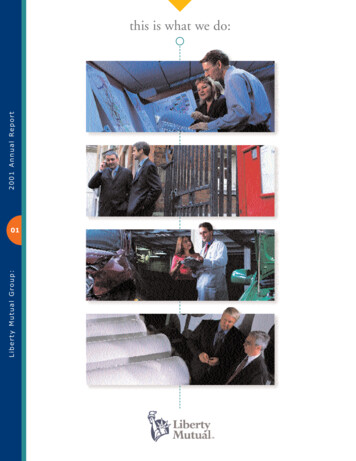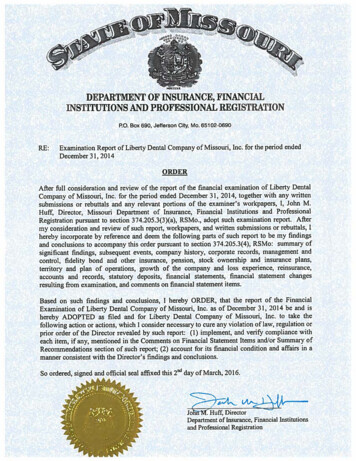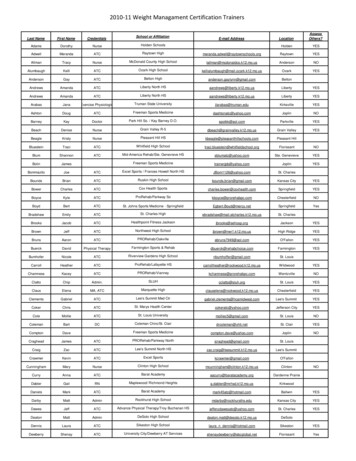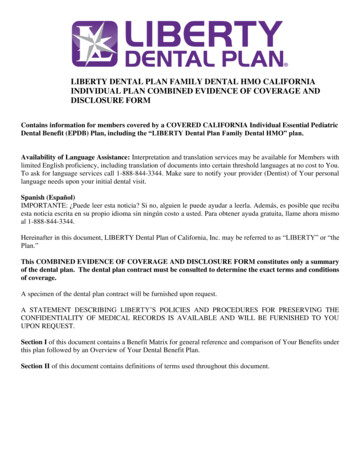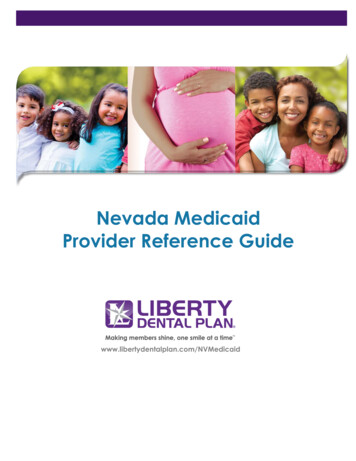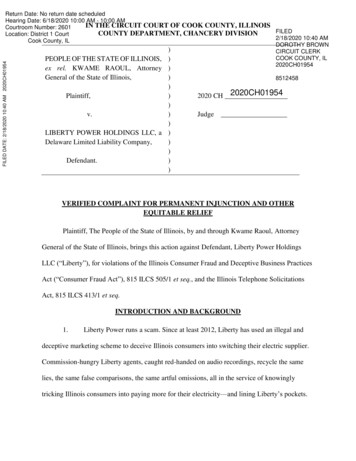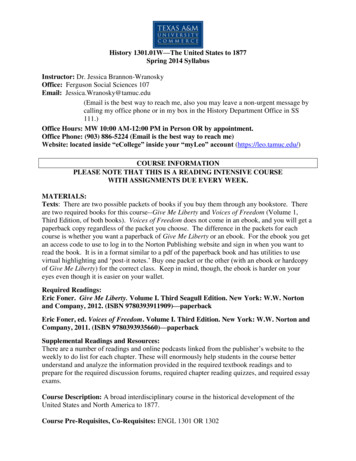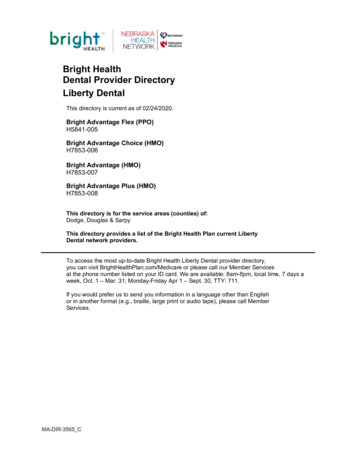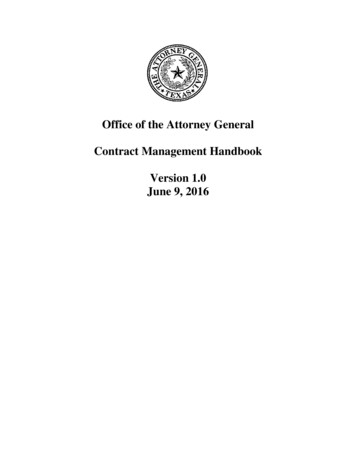
Transcription
Office of the Attorney GeneralContract Management HandbookVersion 1.0June 9, 2016
Table of Contents1Contract Management Overview .52Contract Management Team Roles and Responsibilities.62.1345Contract Management Team (CMT) .6Contract Procurement .73.1Contract Planning .73.2Procurement .73.3Contract Formation .7Contract Management .84.1Budget Management .84.2Risk Management .84.3Communication .84.4Contract Monitoring .84.4.1Remedy Assessment . 84.4.2Site Visits and Desktop Reviews .84.4.3Contract Performance Reporting .84.4.4Contract Review Process .9Contract Closeout Process . 10OAG Contract Management Handbook v1.02
About This HandbookThe purpose of this handbook, as required by Texas Government Code, §2261.256(b), is to document contractingpolicies and practices consistent with the State of Texas Contract Management Guide (Guide) to be followed by theOffice of the Attorney General (OAG). The activities contained in this document will occur as applicable to a specificcontract. This document provides the global principles for contract management that are further defined in processesand procedures at the division level. There may be policies and/or procedures contained in the Guide that are not foundin this document. In the event that the information in this document contradicts mandatory requirements of the Guide,the Guide shall prevail. These standardized processes are intended to promote the efficient use of resources and toprovide transparency and accountability into the OAG’s expenditure of public funds.The contents of this handbook (including associated processes, forms, and templates) are subject to change. Thecontents are not intended in any way to grant any entitlement or right to any individual or entity. The contents do notconstitute a basis for contesting any bid, offer or proposal made, granted or awarded by the OAG.OAG Contract Management Handbook v1.03
Acronyms and DefinitionsWhen capitalized, the following terms have the meaning set forth in Table 1: Acronyms and Definitions. All otherterms have the meaning set forth in the Merriam Webster’s Collegiate Dictionary, Eleventh Edition.Table 1: Acronyms and DefinitionsTerm/AcronymDefinitionContractA written agreement where a contractor provides goods or services andthe agency pays for such goods and services in accordance with theestablished price, terms, and conditions. For purposes of this handbook,the term may include: (1) grants, (2) interagency contracts, (3) interlocalagreements, and (4) no-cost agreements.ContractorA business entity or individual that has a contract to provide goods orservices to the State of Texas. This term is used interchangeably withthe term “Vendor.”RemedyAlso referred to as Liquidated Damages. A specified contract provisionthat entitles the state to demand a set monetary amount determined to befair and equitable repayment to the state for loss of service, among otherthings, due to the vendor’s failure to meet contract requirements.OAG Contract Management Handbook v1.04
1 Contract Management OverviewIt is the policy of this agency to avoid any and all conflicts of interest and to provide transparency to the citizens ofTexas.All OAG staff working on procurements and/or contracts shall perform their responsibilities with the highest integritythroughout the contract life cycle. Prior to participating on a procurement or contract project, potential team membersmust sign the necessary non-disclosure statements. Additional forms, such as the State Auditor’s Office DisclosureStatement for Purchasing Personnel and recusal forms may be required at later stages of a procurement and contractproject. OAG staff is encouraged to review non-disclosure statements, ethics training, and other documents whichreference the applicable statutes. The Texas Ethics Commission also provides guidance and interpretation ofapplicable statutes.The General Counsel Division and the Child Support (CS) Legal, Policy, and Program Operations Division play asignificant role throughout the contract management lifecycle by providing legal advice to the Contract ManagementTeam (CMT). Depending on the situation, review and approval by the General Counsel Division and/or the CS Legal,Policy, and Program Operations Division may be required prior to final action by the CMT.OAG Contract Management Handbook v1.05
2 Contract Management Team Roles and Responsibilities2.1Contract Management Team (CMT)A Contract Management Team (CMT) performs the daily activities associated with managing a contract – planning,procurement, contract formation and contract oversight. The team may be comprised of one (1) or more individualswith the functional titles of, for example, Contract Manager, Contract Administrator, Project Manager, Contract Lead,or Contract Specialist and can have a variety of classification titles. The CMT structure may change depending on anumber of contract variables such as:1. Contract complexity and/or dollar value.2. Level of risk.3. Specific services and deliverables.4. Level of monitoring.5. Documentation and records retention.6. Level of reporting.For each contract (or in some cases, each group of similar contracts), a CMT is established that may perform thefollowing functions:1. Participates in the creation of clearly defined contract deliverables, contract management activities, andcontract performance indicators throughout the procurement process.2. Performs contract start-up activities.3. Works with stakeholders within the context of performing ongoing contract management activities to meetcontract requirements.4. Ensures that OAG business objectives are met throughout the life of the contract.5. Establishes, implements, maintains, and manages contract management processes documented in the Guide.6. Monitors contract activities and measures performance.7. Maintains contract documents.8. Performs appropriate tasks to ensure efficient contract transition.9. Manages communication.NOTE: Staff may perform other functions that are not contract management related and will not be covered in thisdocument.OAG Contract Management Handbook v1.06
3 Contract ProcurementNOTE: Not all procurement activities contained in this section are applicable to grants, interagency contracts,interlocal agreements, and no-cost agreements.3.1Contract PlanningThe CMT determines if a business need should be addressed with a new solicitation or if the need continues and anexpiring contract should be procured again. In the planning phase, the team must clearly identify general contractingobjectives, assumptions, and constraints.3.2ProcurementA procurement project team may be formed during the solicitation planning phase. The team may include membersfrom the business area needing contracted services and other areas specializing in the administrative aspects ofprocurement and contracting (e.g., Contract Operations, Contracts and Asset Management, Procurement and GrantOperations, General Counsel and CS Legal, Policy, and Program Operations Divisions).The procurement project team may develop a solicitation document, evaluate bidders and the proposed solutions, andaward a contract in accordance with the planned goals and objectives.3.3Contract FormationThe OAG executes a written contract to serve as a reference document that records the terms of an agreement toprevent misunderstanding and conflict as to those terms at a later date, and creates a legal, binding and enforceableobligation.OAG Contract Management Handbook v1.07
4 Contract OversightNOTE: Not all activities are applicable to all contracts, grants, interagency contracts, interlocal agreements, and nocost agreements.Contract Oversight includes budget management, risk management, communication, and contract monitoring.4.1Budget ManagementBudget Management includes adjusting and tracking the budget, and reporting information regarding the budget,purchase orders, and invoices to management or others as required. In this section, the term budget refers to fundsallocated to a specific contract or business area for financial management.4.2Risk ManagementThe CMT reviews contracts to assess risk for security incidents and contract non-compliance. The CMT identifiesissues or risks associated with a given contract using various risk assessment methods. Results of any risk assessmentsare used by the CMT to determine the frequency of contract monitoring.4.3CommunicationThe CMT manages contract communications and ensures significant contract events are captured, emails are retained,and contract issues are tracked. Written communications between the OAG Contract Manager and the Contractor’srepresentative via electronic and paper means are types of contract communications.4.4Contract MonitoringThe CMT will determine the appropriate levels and methods of Contract monitoring which may include evaluatingaccountability, performance, compliance with applicable law, rule, and policy. Monitoring contracts includesvalidating deliverables and Service Level Agreements (SLAs) to ensure contract requirements are met.4.4.1Remedy AssessmentThe CMT assesses Remedies and requires a corrective action plan when necessary.4.4.2Site Visits and Desktop ReviewsThe CMT reviews the Contractor’s processes and procedures that support an executed contract. Conducting site visitsand observing the work being performed are methods that may be used by the CMT to validate that all contractrequirements are met and to identify potential risks. Site visits and desktop reviews are performed in addition toreviewing the output of a Contractor’s product or service.4.4.3Enhanced Contract and Performance MonitoringThe CMT conducts a risk assessment to identify contracts that require enhanced contract or performance monitoringand reports information on these contracts to the First Assistant Attorney General at least quarterly. In case any seriousissue or risk is identified with respect to a contract, the First Assistant Attorney General is notified immediately.4.4.4Contract Performance ReportingThe CMT may provide periodic contract performance reports. Reporting frequency and level of detail vary by contractcomplexity.The CMT may generate detailed and summary level reports to identify trends and potential performance issues.The reporting process can:1. Establish criteria for reportable events.2. Identify the appropriate content for a specific audience or purpose.3. Promote awareness of issues from staff to management.OAG Contract Management Handbook v1.08
4.4.5Contract Review ProcessThe contract review process should occur:1. As part of routine contract management to determine if adjustments or early terminations are needed.2. For each contract to consider if renewal, expiration, termination, or a new procurement is needed.OAG Contract Management Handbook v1.09
5 Contract Closeout ProcessOnce a decision is made to terminate a contract, the closeout process proceeds. The CMT works with stakeholdersand the Contractor to ensure close-out steps are taken.OAG Contract Management Handbook v1.010
OAG Contract Management Handbook v1.0 3 About This Handbook The purpose of this handbook, as required by Texas Government Code, §2261.256(b), is to document contracting policies and practices consistent with the State of Texas Contract Management Guide (Guide) to be followed by the Office of the Attorney General (OAG).
